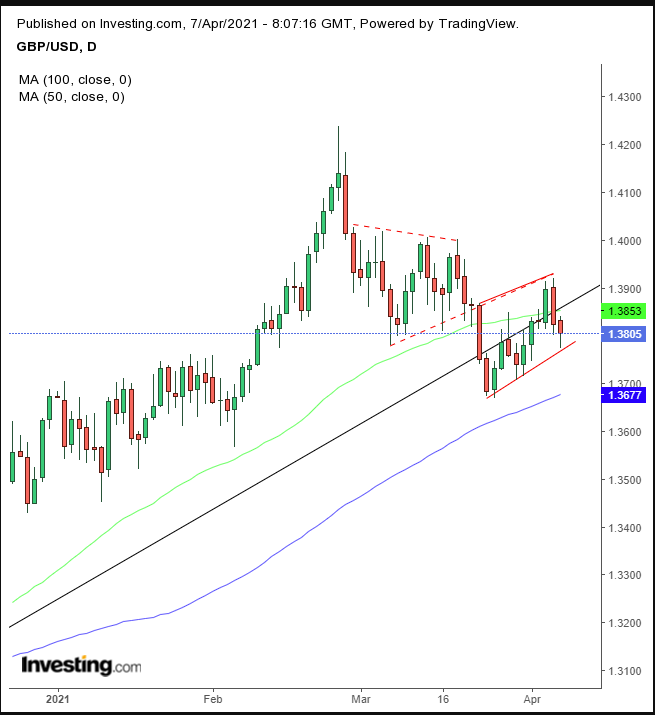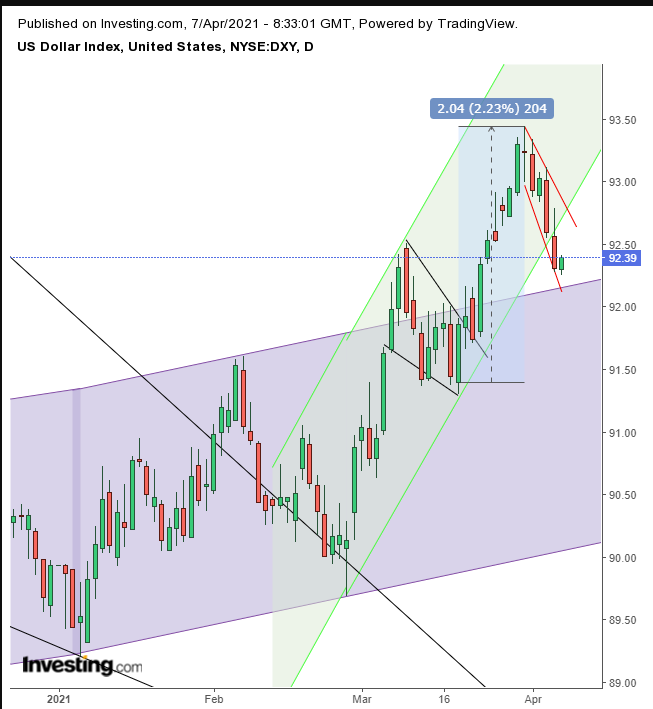- UK and European stocks outperform
- US dollar may have found a floor
- Gold slides
- The 2021 Spring Meetings of the IMF and the World Bank Group take place virtually this week. Federal Reserve Chairman Jerome Powell takes part in a panel about the global economy on Thursday.
- Japan releases its balance of payments numbers on Thursday.
- China’s consumer and producer prices data are due for release on Friday.
- S&P 500 futures climbed 0.2%.
- NASDAQ 100 futures gained 0.2%.
- The FTSE 100 Index increased 0.8%.
- The STOXX 600 was little changed.
- MSCI Asia Pacific Index was little changed.
- MSCI Emerging Markets Index jumped 0.6%.
- The Dollar Index rose 0.1%.
- The British pound declined 0.2% to $1.3797.
- The euro was little changed at $1.1878.
- The yen was flat at 109.81 per dollar.
- The yield on 10-year Treasuries fell three basis points to 1.63%.
- The UK 10-year yield fell two basis points to 0.78%.
- Germany’s 10-year yield dipped two basis points to -0.34%.
- West Texas Intermediate crude added 0.5% to $59.61 a barrel.
- Gold dipped 0.1% to $1,740.89 an ounce.
Key Events
Futures on the Dow, S&P, NASDAQ and Russell 2000 as well as global stocks wavered near record levels in trading on Wednesday, despite a continued slide in yields ahead of the release of the FOMC meeting minutes at 14.00 EST.
Oil edged lower before the EIA inventory report.
Global Financial Affairs
S&P 500 and Dow Jones futures hovered near all-time highs even as the underlying gauges fell on Tuesday on lower volume which fell below 10 billion shares for the first time in 2021.
The European STOXX 600 Index was little changed after hitting a new record on Tuesday for the first time since Feb. 19 2020. Regional investors have been closely watching the eurozone's services data release.
The rapid vaccine rollout in the UK, compounded by a weaker pound sterling—rendering exports, for the island-country, more competitive on the world market—boosted the FTSE 100 to its highest level since Feb. 26.

The pound was struggling for a trading path, as it slipped below the uptrend line since the March bottom, as it appeared to develop back-to-back bearish patterns.
Stocks in Asia, following a Wall Street retreat on Tuesday, were uneven. Australia’s ASX 200 outperformed as the country’s dependence on commodity exports benefited from rising crude and metal prices, amid the reflation trade ahead of an expected global economic recovery.
In contrast, shares in China—the world’s largest commodity importer—underperformed, with China’s blue-chip A50 index down 1.6%.
On Tuesday, the S&P 500 and Dow Jones closed off all-time highs in the slowest trading day of the year. Volume has been falling in the last few sessions, as investors plot a course ahead of the upcoming earnings season, during when sector rotations may get wild.
Yields on the 10-year Treasury note sold-off for the second day, having lost their grip on an advance, demonstrating that traders expect the Federal Reserve to tighten policy, despite all the promises to the contrary.
Today's FOMC minutes may reveal whether this suspicion is justified, or whether it’s just confirmation bias. Investors are growing desperate for a safe investment that can also provide a return as many stocks continue to trade at their most expensive.

The increasing nervousness that the Fed's accommodative policies will be removed has kept yields ranging since mid-March. A fall below 1.58% would complete a top, as the indicators show it might. For as long as yields remain within the rising channel, odds are they are continuing higher.
The dollar appeared to find its footing after dropping out of its recent rising channel, perhaps finding support at the previous, more tempered rate of ascent, which followed the huge falling wedge starting at the March peak.

A rebound now may complete a falling flag, bullish after the preceding 2.25% surge.
Gold was the mirror image of the dollar, heading south.

The precious metal appears to have found resistance by the top of a bearish flag. Will the flag hold, confirming a steeper decline, or will a break out of its narrow falling channel since the Jan. 6 peak, backed by bullish indicators, blow out the flag and propel prices back to the top of the more tempered falling channel since the March high?
Naturally, we don’t know, but as long as the price remains below $1,755, we’re betting on the flag.
Oil gave up a second day advance. The tumble was said to be due to falling inventories and a bullish outlook due to the restarting economy, helped by the most generous fiscal policy in history. However, there are concerns in some quarters about the potential for devastating policy changes by the Biden administration
The price completed a rising flag, bearish after the preceding plunge that took the price out of its rising channel. A decisive downside breakout would also complete a H&S top and a peak-trough downtrend. Both the MACD and the RSI provided a bearish picture, with the latter also triggering a negative divergence when the price rose between February and March.
